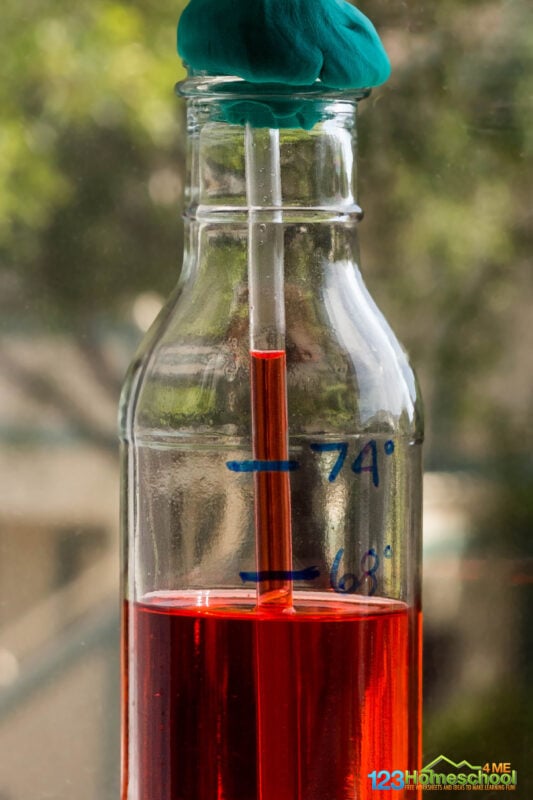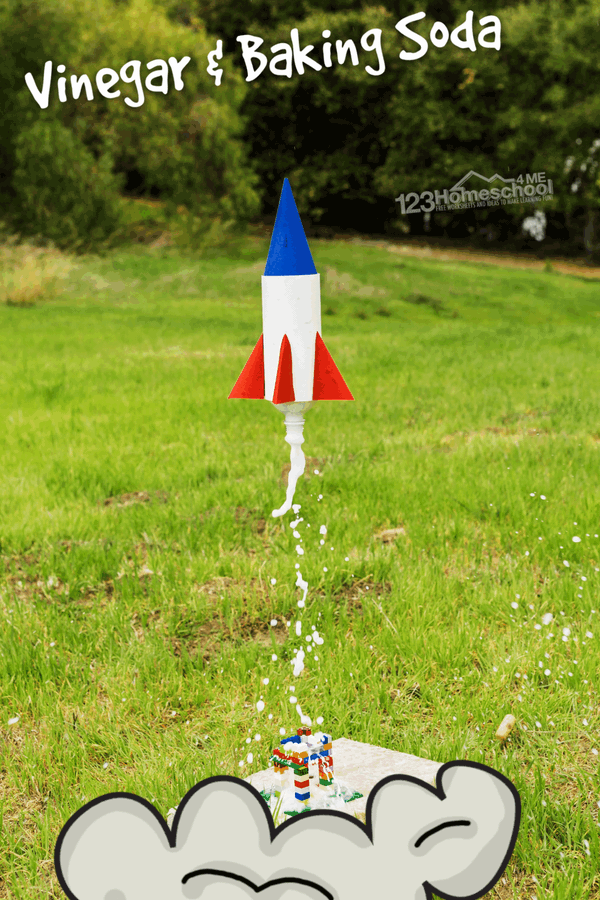If you are looking for a really cool science experiment that will wow kids, you’ve got to try this homemade thermometer. With just a couple simple materials you can make your very own, working homemade thermometer experiment. This diy thermometer is fun to learn about weather, tempearture, and so much more with preschool, pre-k, kindergarten, first grade, 2nd grade, 3rd grade, 4th grade, 5th grade, 6th graders, and up!
Homemade Thermometer
You can make a quick and easy homemade thermometer that will tell the temperature of it’s surroundings! This homemade thermometer science project works because the liquid will expand when warmed and contract when cooled. Once you have your temperature markings you will be able to see the rise and fall of temperature using this weather experiment. Whether you are a parent, teacher, or homeschooler – you will love making a homemade thermometer with your preschoolers, kindergartners, grade 1, grade 2, grade 3, grade 4, grade 5, and grade 6 students. Get ready to WOW your kids with this easy science experiment!
homemade thermometer experiment
All you need to try this fun weather activity for kids, teaching them how a thermometerworks, are a few simple materials:
- empty glass botte (like from starbucks frapaccino)
- water
- rubbing alcohol
- food coloring
- clear straw
- modeling clay or playdough
- marker
- instant read thermometer
diy thermometer
Start by adding water to a clean, empty, glass bottle. You want the conatiner to be about ¼ full of plain water.
Cool Science Project
Then, add an equal amount of rubbing alcohol, also known as isopropyl alcohol, so that the bottle is half full.
homemade thermometer project
Add a few drops of food coloring. It doesn’t have to be red, it can be any color you like. But since a thermometer is typically red, we went with that for kids to more easily make the connection of what we were making.
homemade thermometer science project
Put your clear straw into the bottle, and holding it so that it does not touch the bottom but is suspended slightly in the liquid, wrap the playdough or modeling clay around the top of the bottle and the straw. This will hold the straw in place and prevent it from falling farther into the bottle.
making a homemade thermometer
Now take your instant read thermometer and note the temperature. Make a mark on your jar with your marker noting the temperatur end height of the liquid in the straw.
Weather Experiment
Move your homemade thermometer bottle to different locations where the temperature is likely to be different. We took our DIY thermometer outside and got a much higher reading. Again, use your digital thermometer to note the actual tempearture and make markings on the bottle.
Notice how the liquid either rises or sinks down in the straw. In warmer temperatures, the liquid will rise. In cooler temperatures, it will sink.
Easy Science Activity for kids
Try placing the bottle in direct sunlight, on a porch outside on a warm day, or in the refrigerator to see the liquid in the straw rise and fall with the temperature variation.
Homemade thermometer explanation
The liquid in the bottle expands when it is warmed, and contracts when it cools. There is only so much space at the bottom of the bottle, so when the liquid gets warmer, it rises in the bottle and is forced up into the straw. When the liquid is in a cooler environment again, it will begin to contract, moving down the straw. While this experiment won’t give you an exact temperature, only a real thermometer can do that, it will allow you to generally see which environments are warmer or cooler than others. And the more you lable the bottle, the more you can depend on the readings to tell what the weather is really like!
Weather Activities
Learn how to make an EASY, working homemade thermometer. This fun science experiment teaches about weather and more with kids!
Fun Science Experiments
Here are some of our most popular lessons and activities or see all our science for kids conveniently sorted!
- 30 Simple Machines for Kids Experiments
- Launch this experiment and record your findings with this Coke and mentos experiment worksheet
- Lots of FUN Solar System Project Ideas for kids
- Printable Solar System Worksheets (free) or planet worksheets for kindergarten
- Grab these free printable solar system coloring pages
- Simple pop rocks experiment for kids (with free worksheet)
- Stunning chromatography butterflies
- Life-size Human Body Project with free printable body parts
- Colorful Capillary action science experiment (also known as walking water)
- 100 Amazing Food science experiments – arranged by type of science
- Free Printable Human Body for Kids Playdough Mats
- Leak proof bag fun science experiments
- Older students can dive deeper with these free skeletal system worksheet pages
- Amazing Why do leaves change color experiment
- Learn about seasons with this cool free 4 seasons printables
- Animals and their Babies matching puzzles
- Take a closer look at animals with this free printable animal report for for kids
Science Exeriments for Kids
Looking for lots more fun, science experiments for kids? You’ve GOT to try some of these outrageously fun science experiments for kids! We have so many fun, creative and easy science experiments for elementary age children:
- How to Make a Lava Lamp – super easy and SO cool!
- Weather Unit for prek-3rd graders filled with experiments, activities and weather worksheets
- Make it rain and write your observations in these cloud in a jar experiment worksheet
- Learn about our moon with these activities and moon worksheets for 1st grade
- Free Water Cycle Worksheets for kids
- Discover a world of geology with these rock worksheets for kids
- Free printable states of matter activity with clip cards
- Discover what lies below the surface with these free Layers of Earth Worksheets
- Make playdough earth layers with this super cool geology experiment for kids
- LOTS of year-round Science Experiments for Kids
- Kids will love this outrageously fun pipe clean constellations activity
- This look inside a volcano experiment for kids takes learning to a whole new level
- Chromatography Butterflies project for kids
- Learn about the kingdom Animalia with over 20 Zoo Scavenger Hunt free printables
- Harness the power of fruit with this simple Lemon Clock for kids
- Learn about famous female inventors with this read, color, and learn booklet for kids
- Easy Bernoulli’s principle experiment at home
- Amaze kids with this simple burning candle experiment with free worksheets
- Free Printable Periodic Table Worksheet set
Easy Science Experiments
Explore our science projects based on all science for kids, types of free science lessons, or seasonal science experiments.
- Gross and so cool Digestive System Project for kids of all ages
- Amazing Rainbow in a Jar Experiment for Kids
- Epic Baking Soda and Vinegar Rocket Experiment
- Cool Milk and Vinegar Expeirment making plastic!
- Learn about your amazing brain with this activity and brain worksheets
- How do hands work project for kids
- Super cool and easy-to-make, working lego balloon car
- Plants for kids lesson
- Bouncy Naked Egg with FREE egg in vinegar experiment worksheet
- Explore magnets with these EPIC magnet experiments for kids
- Popsicle Stick Catapult for kids – simple STEM project
- Simple light bulb experiment (it actually lights up!)
- Easy-to-make balloon hoovercraft
- Bouncy Eggs and eggs in vinegar experiment worksheet
- Learn about density for kids with these simple balloon solid, liquid, gas hands-on activities
- Create your own super simple bot
- Beautiful, color changing capillary action experiment with flowers
- WOW your kids with how to make a Newton’s cradle project
- Heat-sensitive, Color Changing Slime is SO COOL!

























Leave a Reply